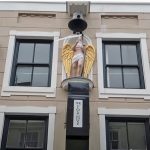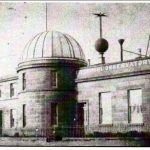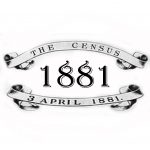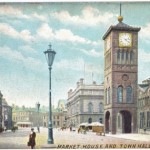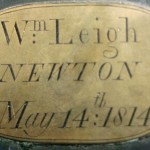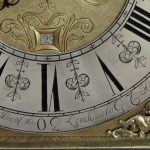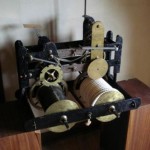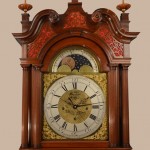Click the thumbnails below to view the whole images.
- Winters Shopfront, Stockport
- Could this clock accurately predict the times and heights of tides at Liverpool?
- Liverpool Observatory at Waterloo Dock
- Watchmaking in England through the lens of the 1881 census
- The clock tower at Blackburn Market Hall
- William Leigh’s name plates record the date of installation
- The Coy Man signature
Jacob Winter’s shopfront in Stockport, Cheshire: its history, context and conservation. This was published in two parts in March and June 2023.
Jacob, the fourth son of Jewish migrants from Poland and Germany, was apprenticed to a watchmaker and went on to establish a watchmakers and jewellery business in Stockport, Cheshire. The business flourished and from c.1904, his premises on Little Underbank was adorned with a projecting clock and three jacks: a guardsman, a sailor and Father Time who chimed and struck the hours on bells. This became a local ‘tourist attraction’ and has recently been restored as part of a Stockport MBC project. What was the motivation behind its creation? How has the mechanism survived up to the present? How was it restored? All this is told plus the story of a local business, in our article. To read about it, click Part 1 and Part 2.
John Kaye of Liverpool – Can his clock predict the time and height of high water at Liverpool? This was published in Antiquarian Horology in March 2021.
Much has been written about rolling moon tidal dials which show the time of high water at a particular location. The clock by John Kaye, which provides the focus for this article, has a universal tidal ring attached to its moon dial, but also shows the time, and uniquely the height of high water, using three other parts of its dial, namely: data engraved on a fixed arch (above the moon dial), data engraved on a subsidiary dial showing the effects of the moon’s elliptical orbit, and data engraved on a second subsidiary dial showing the effects of wind speed and direction. Our purpose was to understand and use this extra data and to establish its accuracy (particularly the heights of high water) both when it was made c.1775 and today. In addition, the clock took us on a round-the-world voyage, led by the locations on its chapter ring; the accuracy of the placement of these and the reasons for their selection was also studied. Click here to view.
Getting the right time. Liverpool’s contribution in the mid nineteenth century. This article explains the vital role played by Liverpool Observatory at Waterloo Dock from 1844 to 1866 and thereafter at Bidston Observatory, just across the Mersey. The Observatory was set up with three main objectives concerning time. These were: to establish the longitude of Liverpool; to test chronometers to discover why ships were still lost at sea; and to disseminate the correct GMT to ships’ captains and to the population of the town. The article appeared in Antiquarian Horology in two parts – Part 1 and Part 2.
A snapshot of the watchmaking industry in England through the lens of the 1881 census. The census offers us a glimpse of the industry in England on the night of Sunday 3rd April 1881. What was recorded then may not have been true the previous day or the day after it was literally a snapshot in time. The population was required to supply its age, gender, marital status, relation to the head of household, occupation and birthplace. Using data gleaned from these fields enables a vast amount of information to be analysed and a picture of the time to be created. It is well known that watchmaking in England experienced a steep decline during the second half of the nineteenth century and the country was gripped by a long depression, so what was left of the industry in 1881? 1881 article part 1 and part 2.
The long and expensive pursuit of an accurate timekeeper in Blackburn, Lancashire
This article follows the trials and tribulations suffered by the people of Blackburn as their town council struggled to bring the correct time to their town between 1848 and 1890. Click here.
William Leigh of Newton-le-Willows, Clockmaker 1763-1824. This article was published in two parts in Antiquarian Horology, in March 2012 and June 2012. Part 1 or Part 2.
Thomas Hampson of Wrexham – His Chester phase. The article describes how we were able to link the ‘Coy Man Clock’ to what we believe was its original home almost three hundred years ago. Click here.
NEWS following up on these articles
Another clock by William Leigh has recently come to light. We believe it came from Shaw Hill House at Whittle-le-Woods, Lancashire. It is dated 29th Aug 1807. At that time the owner of Shaw Hill House was Richard Crosse-Legh, so this is another clock with a connetion to the Legh family. The clock is believed to have been in the stable block, but this was demolished many years ago. The main house was rebuilt sometime between 1830-40 and is now Shaw Hill Golf and Country Club, http://shaw-hill.co.uk/hotel/ Click the thumbnails below to see larger images.
- William Leigh’s name plates record the date of installation
The longcase image above is from Allan Smith Antique Clocks. Click the link to view more images. Until seeing this clock, we were unaware that William Leigh signed any of his clocks with a Liverpool location. If anyone knows of others signed in this way, please email us, we will be delighted to hear from you.
http://www.inbeat.org/wp-content/uploads/2020/03/Liverpool-Time-part-1-section-C.pdf

